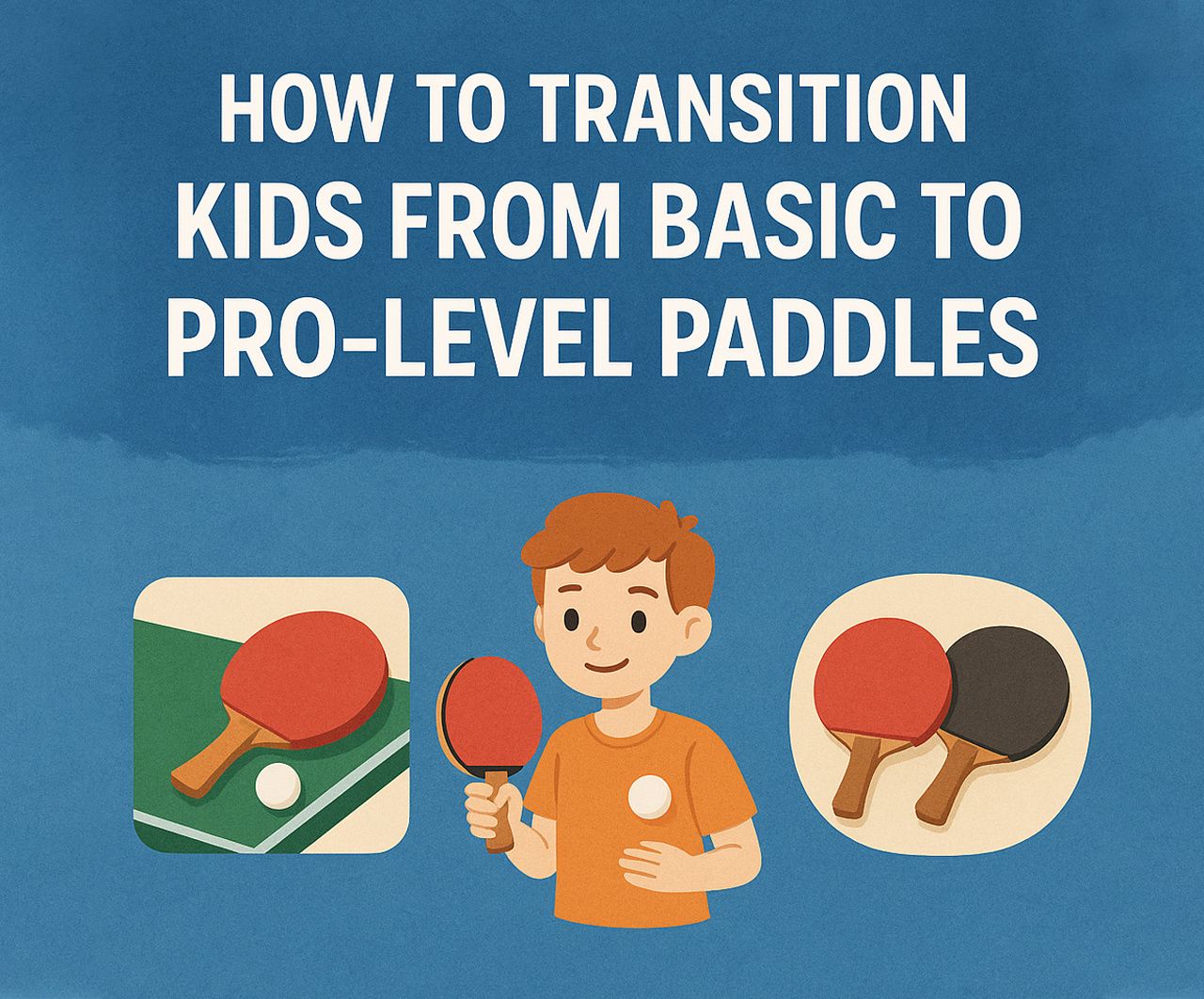When it comes to transitioning kids from basic to pro-level paddles in pickleball, it’s essential to ensure that both the equipment and the skill set evolve together. Starting with plastic pickleball paddles is a great introduction, but as kids improve, they’ll need to move to more advanced equipment, like carbon fiber pickleball paddles, to keep up with their growing abilities. Additionally, using mini pickleballs can help younger players develop control and technique before switching to full-sized paddles. This guide will outline the process of transitioning kids from beginner to pro-level paddles, ensuring they are set up for success on the court. Know more..
1. Why the Right Paddle Matters for Kids
Pickleball, like any other sport, requires the right equipment to help kids grow and improve. The paddle is one of the most important pieces of equipment because it directly affects a player’s ability to play the game. In the early stages, plastic pickleball paddles are typically ideal for kids because they are lightweight and easy to handle. However, as children’s skills develop, they’ll need more specialized paddles to help them advance their game.
Starting with Plastic Pickleball Paddles
Plastic pickleball paddles are often the first paddles kids use because they are affordable, durable, and light. These paddles make it easy for beginners to learn the fundamentals of the game. The softer surface of the plastic paddles is forgiving and helps kids with ball control. They are excellent for practicing basic shots like serves, volleys, and dinks.
However, as kids improve their technique and strength, plastic pickleball paddles may start to limit their performance. These paddles often lack the power and precision needed for higher-level play. At this stage, it becomes essential to move on to more advanced paddles that can help kids develop their game further.
Upgrading to Carbon Fiber Pickleball Paddles
Once your child has mastered the basics and is looking to take their game to the next level, carbon fiber pickleball paddles become an excellent choice. These paddles are known for their lightweight construction and superior performance. Carbon fiber pickleball paddles offer increased power and control compared to their plastic counterparts, making them a favorite choice among more advanced players.
The unique design of carbon fiber pickleball paddles allows for better precision when hitting the ball, which is key as kids move into more competitive play. The surface of these paddles is often textured to provide enhanced spin, allowing players to put more spin on the ball, making it harder for opponents to return. Additionally, carbon fiber pickleball paddles are more durable, and their construction can help absorb some of the shock when hitting powerful shots, reducing hand fatigue during longer games.
The Role of Mini Pickleballs in Skill Development
Before jumping into full-sized paddles and high-level gameplay, it’s beneficial for young players to practice with mini pickleballs. These smaller, lighter versions of the standard pickleball are perfect for helping kids develop the necessary control and hand-eye coordination.
Mini pickleballs are especially useful when transitioning from beginner to intermediate skill levels because they allow players to practice their swings and ball control without being overwhelmed by the larger, heavier standard-sized pickleball. Because mini pickleballs are slower and more manageable, they allow kids to focus on accuracy and technique, making it easier to transition to a full-sized ball once they are comfortable with their skills.
2. When to Transition from Basic to Pro-Level Paddles
Transitioning to pro-level paddles should be done gradually and based on your child’s skill level. Here are a few signs that indicate it’s time to move from plastic pickleball paddles to carbon fiber pickleball paddles:
1. Mastering the Fundamentals
Your child should have a solid understanding of the basic techniques—such as grip, stance, and stroke mechanics—before transitioning to advanced paddles. They should also be comfortable handling the plastic pickleball paddles and understand how to play both offensively and defensively.
2. Improved Strength and Stamina
As kids develop their muscles and endurance through practice, they will need a paddle that can keep up with their increased power and stamina. At this point, carbon fiber pickleball paddles can offer the power needed to make more aggressive shots, which will be essential in competitive games.
3. Desire to Compete
Once kids show a desire to compete and are taking their skills more seriously, upgrading to carbon fiber pickleball paddles will give them a competitive edge. These paddles are designed for high-performance players, allowing them to maximize their potential in game situations.
3. Key Considerations for Choosing the Right Pro-Level Paddle
As you transition kids to carbon fiber pickleball paddles, there are several factors to consider to ensure the paddle suits their playing style and needs.
1. Paddle Weight
One of the most important considerations when moving from plastic pickleball paddles to carbon fiber pickleball paddles is weight. The weight of the paddle affects the player’s power, control, and comfort. Heavier paddles offer more power but can be harder to control, especially for younger players with less arm strength. Lighter paddles provide more control but may not generate as much power.
A good rule of thumb is to start with a medium-weight carbon fiber pickleball paddle and adjust based on your child’s preference. Most kids will feel comfortable with a paddle weighing between 7 and 8 ounces.
2. Grip Size
Proper grip size is crucial for controlling the paddle and avoiding injury. If the grip is too small, the paddle can slip during shots, and if it’s too large, it can cause discomfort or hand fatigue. When transitioning to a carbon fiber pickleball paddle, make sure to measure your child’s hand size and choose the appropriate grip size.
4. How Mini Pickleballs Can Help with the Transition
As kids approach the transition from basic paddles to pro-level paddles, it’s useful to practice with mini pickleballs. The smaller balls are slower and easier to hit, making them ideal for refining hand-eye coordination. They allow kids to focus on developing key skills such as:
- Ball Control: With a lighter ball, it’s easier for kids to control the direction and spin of their shots.
- Footwork: Mini pickleballs require less reaction time, giving players the opportunity to focus on their movement around the court.
- Swing Technique: Kids can practice proper swing mechanics without being distracted by the larger, faster full-sized pickleball.
Once your child feels comfortable handling mini pickleballs, they will be ready to move to the standard-sized ball with more confidence. The transition will be much smoother as their skills will have been developed with the smaller ball, and they will have greater control when they start using full-sized paddles.
5. Practice with Pro-Level Paddles
Once your child is ready for carbon fiber pickleball paddles, the real work begins. Practice sessions should include a mix of basic drills with a focus on technique and game simulation. As kids progress, they should practice with the carbon fiber pickleball paddle in real-game situations to adjust to its weight, balance, and performance.
It’s important to encourage kids to play with their carbon fiber pickleball paddles during both practice and competitive matches. Over time, they will become more comfortable with the advanced paddle and develop better power and control.
6. Maintaining the Paddle
As your child moves to carbon fiber pickleball paddles, it’s important to teach them how to take care of their new equipment. Unlike plastic pickleball paddles, carbon fiber pickleball paddles require more attention to ensure they maintain their high performance. Cleaning the paddle regularly and keeping it in a protective case will help prolong its lifespan.
Conclusion
The transition from plastic pickleball paddles to carbon fiber pickleball paddles is an exciting milestone in a young player’s pickleball journey. By starting with the basics and using tools like mini pickleballs to develop control and technique, kids can smoothly make the shift to pro-level paddles. Choosing the right paddle based on weight, grip size, and material is crucial for performance and comfort. With the right preparation and equipment, your child will be well on their way to mastering the game of pickleball and enjoying every match along the way.

